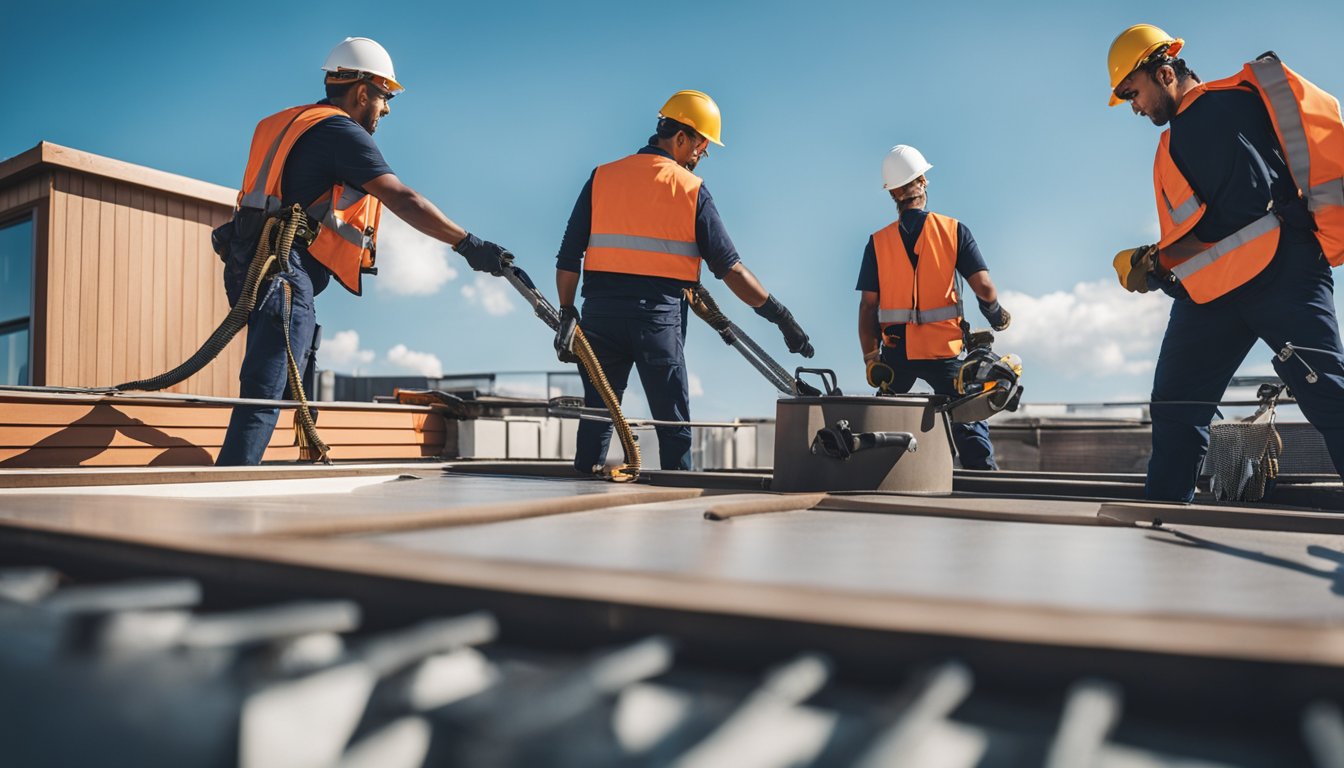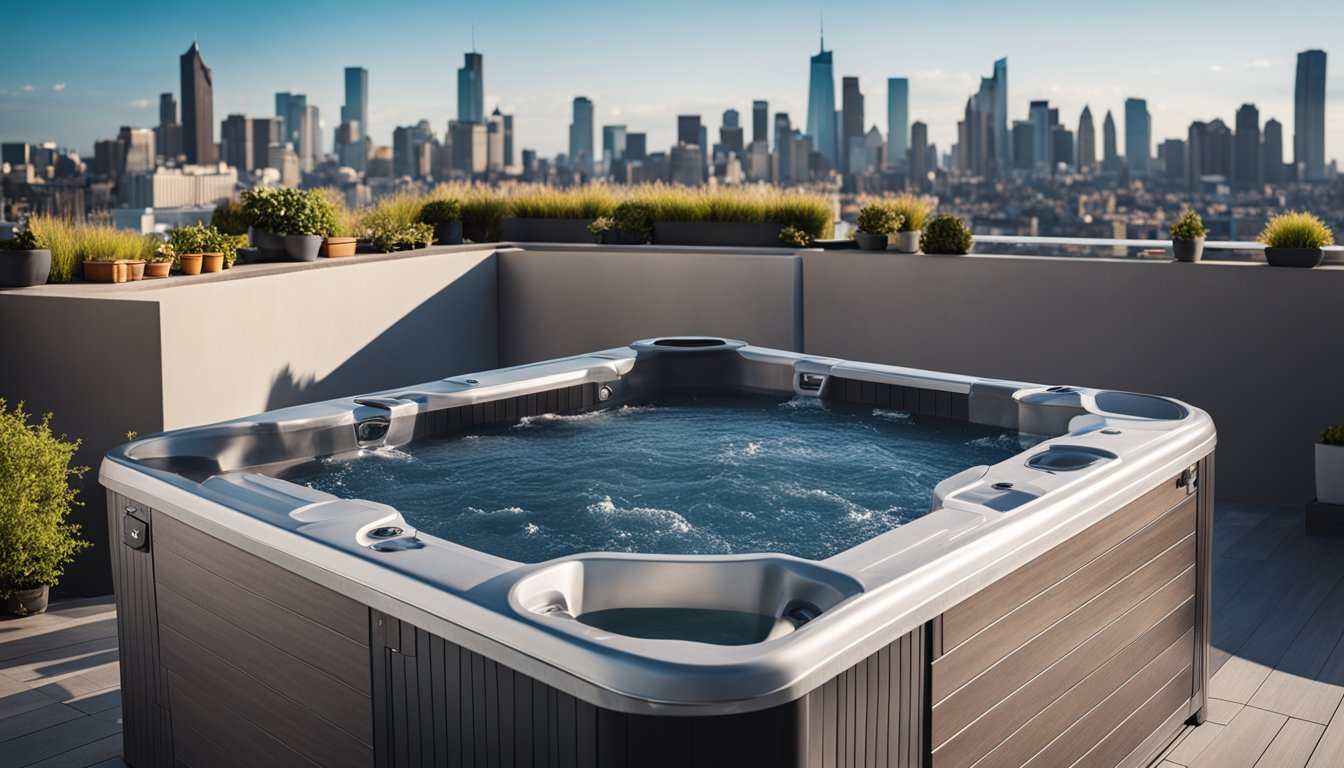Late updated: 30 Jul 2024 09:07
Written by: James Whitaker
Rooftop Hot Tub Installation Advice: Essential Tips for a Safe and Enjoyable Setup
Installing a rooftop hot tub presents an exciting opportunity to create a unique relaxation oasis high above the hustle and bustle of daily life. The allure of soaking in warm, bubbling water while taking in panoramic views is simply irresistible. But such an installation requires meticulous planning and execution. Ensuring the rooftop's structural integrity is paramount before proceeding with any installation efforts.

We must think about the electrical and plumbing requirements, taking into account potential complications with accessibility. It’s essential to hire professionals for critical tasks such as wiring and crane operations to avoid costly mistakes. Proper planning will ensure that we can enjoy the full benefits of hydrotherapy and achieve peace of mind knowing our installation is safe and sound.
While the process might seem daunting, the reward of having a rooftop retreat makes it worth the effort. From determining the best spot to ensuring efficient drainage, every step is vital for achieving an optimal installation. Our guide will navigate through all necessary considerations to help make the rooftop hot tub installation a smooth and stress-free experience.
Key Takeaways
- Ensuring the structural integrity of your rooftop is crucial.
- Professional help is necessary for electrical and crane operations.
- Thorough planning and efficient drainage are essential for a hassle-free installation.
Planning Your Rooftop Hot Tub Installation
Careful planning is essential for a successful rooftop hot tub installation. Key considerations include evaluating the structural capacity, choosing the perfect location, ensuring compliance with permits, and setting a realistic budget.
Evaluating the Structure and Accessibility
First, we must assess the structural integrity of the rooftop. The weight of the hot tub when filled with water and people can be immense. Consulting with a structural engineer is crucial. They can determine whether the roof can handle the load.
We also need to consider accessibility. Routes for delivering the hot tub to the rooftop should be checked. Crane services might be required for heavy lifts. Additionally, we should ensure there is enough clearance for safe manoeuvring.
Choosing the Right Location and Design
Choosing the optimal location on the rooftop involves considering several factors. Ensure that the chosen spot has a solid foundation, such as a reinforced concrete slab that can support the weight.
Design wise, we must think about the aesthetics and practicality. The hot tub should complement the outdoor living space, making it inviting and functional. Considering privacy and wind protection is key.
Complying with Building Codes and Permits
Compliance with local building codes is non-negotiable. Obtaining necessary permits is a must. Regulations might dictate the height of barriers, proximity to edges, and more. Engaging with a professional who understands the local code requirements ensures we avoid costly mistakes.
Safety codes for electrical work also demand attention. All installations must be carried out by certified electricians. This not only ensures safety but also compliance with legal standards.
Budgeting and Preparation
Creating a thorough budget prevents unexpected financial strain. We must account for the cost of the hot tub, installation, structural assessments, and potential reinforcements.
We should also plan for auxiliary costs. This includes crane services, permits, and additional electrical or plumbing work. It's essential to allocate funds for ongoing maintenance to protect our investment.
Effective preparation involves coordinating with various professionals. Clear communication will streamline the process, ensuring the project remains on time and within budget.
Executing the Installation

Installing a hot tub on your rooftop requires meticulous planning and execution to ensure both safety and longevity. Key aspects include ensuring a solid foundation, handling electrical and plumbing requirements, and finalising with essential safety measures.
Constructing the Foundation and Drainage
Foundation is critical to support the weight of the hot tub, water, and users. We recommend using reinforced concrete slabs as they provide the necessary strength and stability. Ensure the structure below can handle the additional load by consulting a structural engineer.
Adequate drainage is also essential. Install a reliable drainage system to prevent water pooling which can weaken the foundation and promote mould growth. Incorporate a slight slope in the foundation and ensure drains are clear of debris.
Managing Electrical and Plumbing Requirements
Electrical connections must be handled by a licensed electrician. A dedicated 220v electrical outlet is typically needed, with installation costs ranging from £300 to £1,000. Proper grounding and circuit breakers are vital for safety. Compliance with local electrical codes ensures all connections are secure and safe.
Plumbing connections require attention to both the water supply and the drainage. Flexible water lines simplify installation and future maintenance. Test for leaks before filling the hot tub to avoid potential water damage. Ensure a balance of hot and cold water supply for optimal operation.
Final Steps and Safety Measures
Final steps involve setting up the hot tub, securing the cover, and verifying that all systems are functional. Use a dolly or crane for large hot tubs to avoid damage during delivery. Check accessibility to ensure user comfort and convenience.
Safety measures are non-negotiable. Install non-slip surfaces around the hot tub to prevent falls. Regularly check and maintain the water quality using sanitizing chemicals. Establish a maintenance routine to inspect the electrical system and plumbing connections periodically. Privacy can be enhanced with outdoor furniture or strategically placed plants.
Prioritising these steps guarantees a safe and enjoyable hot tub experience on your rooftop.
Frequently Asked Questions

For those considering installing a hot tub on a rooftop terrace, there are several important factors to consider. We address common queries regarding structural requirements, preparation steps, safety considerations, building regulations, clearance needs, and best practices for waterproofing and drainage.
What are the structural requirements for installing a hot tub on a rooftop terrace?
The rooftop must support the weight of the hot tub, water, and users. Structural assessments by an engineer are essential to ensure the roof can handle these loads. Reinforcements may be needed to distribute the weight evenly.
How should one prepare a roof deck for the addition of a hot tub?
Clear the area of debris and obstacles. The deck should be level and strong enough to support the hot tub. It might also require additional structural reinforcement. Ensure that pathways are clear for moving the hot tub into place.
What safety considerations are there when installing an outdoor Jacuzzi on a rooftop?
Safety railings around the rooftop are crucial to prevent falls. The hot tub must be close to a power source while adhering to electrical safety standards. Additionally, anti-slip surfaces around the hot tub area are recommended to prevent accidents.
Are there specific building regulations to comply with when fitting a hot tub on a roof?
Local building codes and regulations must be followed. These may include obtaining the necessary permits, adhering to weight limits, and ensuring safe electrical and water installations. Consulting local authorities is advised to ensure compliance.
What factors determine the clearance needed around an above ground hot tub?
Adequate clearance is needed for maintenance and accessibility. Check manufacturer's guidelines for specific requirements. Typically, at least 2-3 feet of space around each side is recommended to allow for easy access and ventilation.
What are the best practices for waterproofing and drainage in rooftop hot tub installations?
Proper waterproofing helps prevent water damage to the building. Use waterproof membranes and sealants. Adequate drainage systems are essential to direct water away from the rooftop to avoid pooling. Regular maintenance of drainage systems also ensures longevity.
